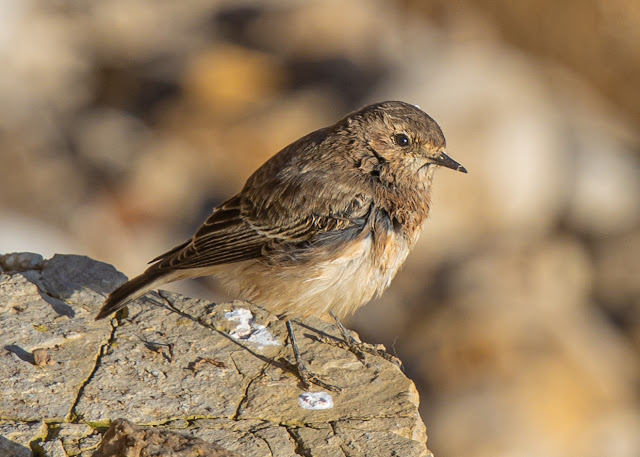 |
| Pied Wheatear |
I hit state pension age on Wednesday and decided to celebrate with a birders style lie in, i.e. up at 04:30 to drive for 4 hours to see a Pied Wheatear near Sunderland!
The early morning drive was uneventful punctuated only by a couple of short break and coffee stops. RBA came on-line at 07:00 but there were no reports of the bird. I was not too alarmed by this as it had been there for a week and I figured that most people who wanted to see it probably had.
The adult male Pied Wheatear is a spectacular looking black and white bird but almost all UK vagrants are first winter birds, presumably indicating that inexperienced migrators are much more likely to get lost. It has a wide breeding range from Southeast Europe through to Western Asia. In the spring and summer it is found eastwards from Romania and Bulgaria right across to Afghanistan. In the autumn in migrates to Northeast Africa for the winter. It favours rough, rocky countryside and is often seen perching on a bush or rock, alert and looking around while bobbing its tail up and down.
The exact location of the bird was in the pleasant seaside suburb of Whitburn on the cliff near a disused rifle range. On arrival I was still surprised that there were no other birders at all present as, while it had been available for a week, this was the first sunny day. RBA normally gives an exact map reference which I can put into my OS locate app and this took me to the edge of the rifle range next to some sandy cliffs. The sea was almost eerily mill pond calm glistening in the pale late autumn sun. I had spent 15 minutes looking for the bird without success when I saw a photographer down below on the stoney beach. He told me that I was in the right location and that he had seen the bird there earlier that morning. He joined me on the cliff top and almost immediate the bird flew into view displaying the prominent white rump which all Wheatears have giving them the old countryside name of white ass. This bird was indeed a first winter female being mainly brown and white with the feathers of the brown upperparts showing pale centres near the tips giving it a somewhat speckled appearance. The Wheatear was true to its recorded habitat and behaviour, perching on a rock on the cliff while looking all around and pumping its tail up and down. It flew up from the stoney beach where it had presumably been feeding, its wet appearance strongly suggesting that it had also just had a morning bath. Over the course of the next two hours it spent most of its time feeding on the beach where it was well camouflaged occasionally jumping up onto the cliff giving us some nice clear views
There are six Wheatear species on the BOU list recognised to have occurred in UK, these being Northern, Isabelline, Desert, Black-eared, Pied and White-crowned Black. With the addition of the Pied I now have all but one on my UK list. The absentee, White-Crowned Black, has only occurred once in Suffolk for 5 days in 1982 and hence will probably not be troubling my UK list any time soon!
An American Wood Duck had been reported a few hundred meters down the coast and I soon found it feeding in a collection of small rocky inlets. Now the Wood duck is a very rare vagrant to the UK. In fact it is so rare that there are precisely zero accepted records on the BOU database! The reason for this is that the vast majority, if not all, sightings in the UK are escapes from collections where they are widely kept. Accepted vagrants have made it as far as the Azores and Iceland so it is not impossible for a wild bird to make it to the UK but for it to be accepted I suspect that it will have to have been ringed as a chick in the US. In common with the introduced mandarin, it is a perching duck quite at home and nesting in trees. In North American it is normally found in fresh water making its current sea location all the more surprising. It has been identified as a first winter male and is unringed.
I paused to take a few pictures of it before making my way back to my car for the 4 hour journey home made all the more pleasant by the warm glow associated with the addition of the Pied Wheatear to my UK life list.
Footnote – my blogs are posted with sometimes rather imaginative spelling and grammar due to my extreme dyslexia!



Well done Lucky Jim! great birthday treat and another one up on me.
ReplyDeleteCheers Nick!!!
Delete